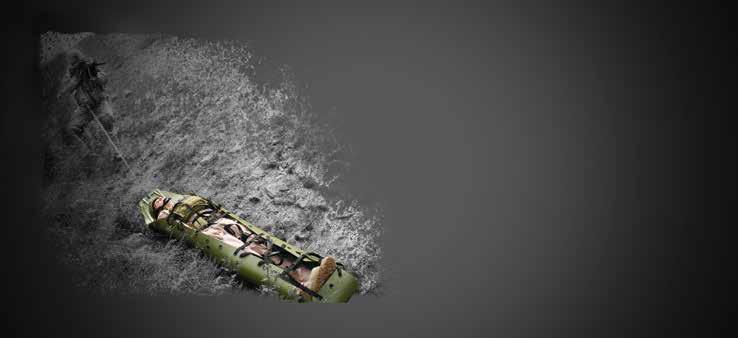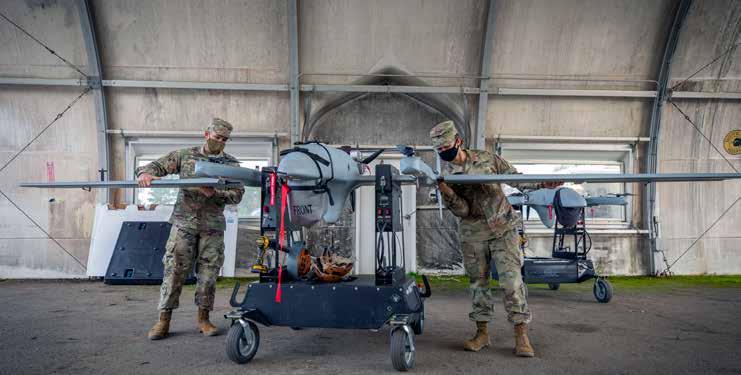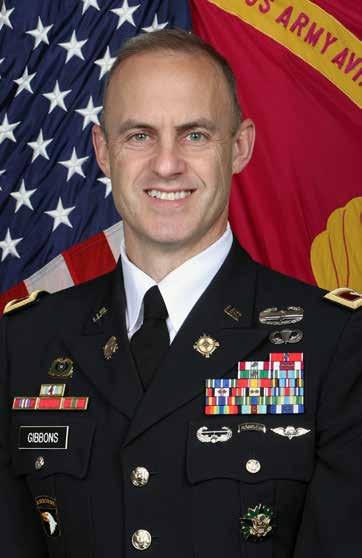
15 minute read
SPOTLIGHT ON INDUSTRY
This screenshot of Command Post Computing Environment (CPCE) software shows operational graphics and layers shared among several simultaneous users in various geographic locations, leveraging a cloud-hosted instance of CPCE for students at the Command and General Staff College. (U.S. Army graphic by Maj. Vincent Cesaro)
requests underwent an assessment to determine the technical level of effort, traceability to requirements and the resources available for execution. The assessment identified a total of 10 categories or areas of improvement and determined it will take approximately eight weeks for software improvements, followed by a 30-day work period to undergo and series of test-fixtest and risk reduction events to determine whether those improvements are ready for operational use.
Advertisement
During WfX 21.4 these improvements were put through the paces. XVIII Airborne Corps users executed their mission and provided additional feedback for future enhancements. Initial feedback indicates CPCE meets all minimum requirements, allowing the Army to focus on improving the user experience for future versions.
PUTTING SOFTWARE TO REAL-WORLD TEST
Following WfX 21.4, Soldiers with the 4th Infantry Division (4ID) at Fort Carson, CO, and I Corps at Joint Base Lewis-McCord, Washington, will utilize CPCE as part of JWA 21 in June, during which a formal Operational Assessment will be conducted using the current Increment 1, or Inc. 1, CPCE software baseline. During the lead up to the exercise, PdM TMC executed a “crawl, walk, run” phased approach with the units to allow users to gain maximum proficiency and provide feedback on the currently fielded CPCE baseline prior to executing the multinational JWA event.

Scan for more Information
Sked® Complete Rescue System
The Sked does multiple duties:

* A litter for evacuating wounded soldiers. * A carrier for dragging equipment (mortar rounds, ammo, etc.) * Also used for breaching concertina wire
Made in USA to save our troops wherever they are.
www.skedco.com Tel: 1-800-770-SKED (7533) Skedco Inc.
Est. 1981
DEVELOPING NEXT-GEN UNMANNED AERIAL SUPPORT FOR FUTURE VERTICAL LIFT
Maj. Ryan Greenawalt serves as Lead Integrator for Future Tactical Unmanned Aerial Systems (FTUAS), Future Vertical Lift Cross Functional Team (FVL CFT).
In 2005, he was assigned to the 3-4 Aviation Battalion (Air Assault) at Fort Hood, Texas, where he served as a flight platoon leader, maintenance platoon leader, and operations officer. Maj. Greenawalt also deployed in support of Operation Iraqi Freedom during his tenure with 3-4 Aviation Battalion. In 2007, Maj. Greenawalt served as an Assistant Team Chief of a Military Transition Team that supported the Operation Iraqi Freedom transition effort. In 2008 he served as the Battalion S3 for the Harrisburg Recruiting Battalion, and in 2011 he commanded the Harrisburg Recruiting Company.
In 2013, Maj. Greenawalt transitioned to the PA National Guard and served in a multitude of positions to include Lead Emergency Response Planner, Contracting Specialist, Assistant Product Manager (APM) within the Fixed Wing Project Office, PEO Aviation, and Army National Guard Liaison to the US Army Aviation and Missile Command. In 2020, he was assigned to the Future Vertical Lift Cross Functional Team as the Lead Integrator for FUAS.

Maj. Ryan Greenawalt, Lead Integrator for Future Tactical Unmanned Aerial Systems (FTUAS), U.S. Army Future Vertical Lift Cross Functional Team (FVL-CFT), spoke recently with Armor & Mobility regarding efforts to replace the trusted legacy RQ-7 Shadow UAS with a FTUAS capability in achieving more streamlined support for the Army’s future vertical takeoff and landing (VTOL) capabilities.
A&M: Can you give us some background on the Future Tactical Unmanned Aircraft System or FTUAS?
Maj. Greenawalt: The RQ7 Shadow tactical unmanned aircraft system has been the workhorse for the U.S. Army for more than 20 years and continues to serve our formations with tremendous results today. In response to Operational Need Statements from several Corps and Division commanders for an RQ-7B Shadow replacement with a runway independent, organically transportable, reduced acoustic signature tactical UAS, the Army adopted a “Buy, try, inform” approach to developing FTUAS to meet the needs of the warfighter.

A&M: What exactly are you looking for in the RQ-7B Shadow’s replacement?
Maj. Greenawalt: Specific desired attributes for FTUAS include runway independence, reduced acoustic signature, organically transportable (Army CH47 v. Air Force C-17), and a reduced logistical footprint.
Maj. Ryan Greenawalt
A&M: What features are most important? Why is it time to replace this system?
Maj. Greenawalt: All of the desired attributes are important and bring advanced capabilities to the Army’s tactical UAS. Runway independence provides significant agility to the employment of the system allowing for launch and recovery almost anywhere on the battlefield. The reduced logistical footprint provides a capability to conduct reconnaissance, surveillance, and target acquisition on the move. With a much quieter aircraft, the enemy is unaware of the FTUAS presence and the ability to organically transport the systems provides additional agility to the Brigade Combat Teams (BCTs).
A&M: What types of missions will the system be used for? What types of payloads will it carry?

Soldiers from the 3rd Armored Brigade Combat Team, 1st Armored Division, Fort Bliss, Texas conduct pre-flight inspections on the L3 Harris FVR-90 unmanned aircraft system. (U.S. Army Photo by Mr. Luke J. Allen)
agile ways of employing tactics, techniques, and procedures. FTUAS is not only becoming more expeditionary, but will deliver additional capability and battlefield sensors and effects for the Brigade Combat Team Commander in a modular and upgradable architecture.
A&M: Can you tell us about the recent FTUAS rodeo and how successful it was?
Maj. Greenawalt: The FTUAS Rodeo was the capstone event following a year-long exercises supporting the BCT. The FTUAS Rodeo was
A&M: What was learned during the demonstrations?
Maj. Greenawalt: Much was learned during the yearlong Soldier touchpoint both from tactical employment of these VTOL systems and technical specific aspects of the systems. Most notable was the relatively ease of set up and employment of the FTUAS. With just two or three Soldiers, the FTUAS were operational in under two hours as compared to the seven hours it takes six or seven Soldiers to employ the RQ7 Shadow.
“We saw agile systems from every performer and the Soldiers uniformly fell in love with their assigned systems. FTUAS gives commanders the ability to command and control on the move, something Shadow cannot provide.” — MG Walter T. Rugen, Director Future Vertical Lift Cross Functional Team
extremely successful. In addition to highlighting Army Futures Command innovative approaches to modernizing our Army, the final input from the Soldiers was collected and set conditions for the Army to accelerate finalizing extremely well-informed requirements.
A&M: How were the systems tested and what was the reaction to them?
Maj. Greenawalt: The systems were used by the Shadow Platoons of each BCT instead of their RQ7 Shadows during the approximately six months they were assigned. Each platoon took their FTUAS to a Combat Training Center as part of their BCT’s training exercise. Soldier reactions were very positive and while some recommendations for improvements were offered, generally most preferred their VTOL FTUAS over the RQ7 Shadow. Most of the Soldiers liked the ease and speed that it took to set up and employ the FTUAS.
A&M: Can you talk about the hands-on experience the five brigades had with the four systems over the last year?
Maj. Greenawalt: Each Shadow platoon had their system for approximately six months conducting home station training prior to deploying to a rotation at either the Joint Readiness Training Center at Fort Polk, LA or the National Training Center at Fort Irwin, CA for participation in large scale combat training and recovery almost anywhere on the battlefield. The reduced logistical footprint provides a capability to conduct reconnaissance, surveillance, and target acquisition on the move. With a much quieter aircraft, the enemy is unaware of the FTUAS presence and the ability to organically transport the systems provides additional agility to Brigade Combat Teams.
Mirion Technologies, supplier of radiation detection and measurement equipment and services, is committed to providing radiation measurement solutions to the global military community that meet or exceed their unique requirements.
By Mirion Technologies’ Homeland Security Team
Mirion has been in the radiation detection, protection, and measurement business for over 60 years and comprises 2,500 talented professionals. Not only are we very passionate about delivering world class products, we also have a service department second to none. Our Mirion Services team offers a broad selection of training available for our products.
ANSWERING MISSION NEED
Through our engagement with military personnel, Mirion gains an in-depth understanding of your needs to create specifically-tailored solutions. At the core of Mirion’s successful relationship with military customers is a respect for their safety and security missions, as well as a common goal of preserving the lives of the warfighter troops and the public. By adapting to the rigorous performance specifications demanded by military customers, Mirion has succeeded in producing long-lasting, rugged handheld radios radiacs, multi-probe handheld survey systems, vehicle-based detection systems, shipboard systems, Robotics/Unmanned Air Vehicle (UAV), training simulator systems and personal dosimetry platforms. Mirion is focused on continuing to bring the best technology to its military customers, allowing you to focus on your core missions.
ADAPTABLE TO EVOLVING THREATS
As the missions of our military customers evolve, equipment needs can change. Mirion’s latest designs feature a flexible architecture that can accommodate your changing requirements. This built-in flexibility has enhanced our connectivity ability as communication platforms evolve. This flexibility has also enabled Mirion instrumentation to be integrated into containerized modular or installed Chemical, Biological, Radiological, Nuclear, Explosive (CBRNE) systems or installed CBRN systems.
The Mirion product family delivers unmatched quality, accuracy, and reliability. These solutions are developed and supported by a staff with extensive and diverse experience in this field. Our product lines represent Mirion’s commitment to the demands related to military applications — detection technology protecting a changing world.
For more information, contact smy-mil@mirion.com or www.mirion.com.
MIRION HAS YOUR TACTICAL DETECTION AND MEASUREMENT SOLUTIONS
Mirion has been in the business of designing, manufacturing and supplying products to military customers for almost three decades. During that time, we have delivered over half a million instruments to U.S. Military and defense forces worldwide.
EVOLUTION OF OUR PRODUCT LINE
APTEC-NRC
AN/PDR-77 Radiation Detection System
AN/VDR-2 Vehicle Mount
AN/UDR-13/-14/15 Pocket Radiac
U.S. DoD-owned Designs
RDS-100P™ Radiation Detection System
MBD-2™ Tactical/ Occupational Personal Dosimeter
RDS-100V Vehicle Mount
RGU-100™ High Sensitivity Military Pocket Radiac Optional Vehicle Mount Horizontal (7083637)
Mirion-owned Designs
Contact us: smy-mil@mirion.com
LEVERAGING MODERNIZATION TO MAXIMIZE MISSION SET
Col. Gregory K. Gibbons serves as Commander, Letterkenny Army Depot in Chambersburg, PA. Gibbons’ initial assignment in 1997 was as platoon leader and later executive officer, A Company, 123rd Main Support Battalion, 1st Armored Division, Germany. From 1999 to 2000, he served as the executive officer, Headquarters and Headquarters Company, Division Support Command, 1st Armored Division. In 2001, his next assignment was as support operations plans officer and later commander, A Company, 296 Brigade Support Battalion, 3rd Stryker Brigade Combat Team (SBCT), 2nd Infantry Division, Fort Lewis, Wash., and Iraq.
Upon returning to the U.S., he was assigned to I Corps as the supply and service material officer in the G-4. In 2005, Gibbons was assigned as Detachment executive officer, 2nd Joint Special Operations Air Component, Special Operations Command Pacific, Okinawa, Japan. From 2008 to 2009 he served as Plans Officer, 101st Sustainment Brigade 101st Airborne (Air Assault) Division in Afghanistan. His follow-on assignment was as the executive officer and support operations officer, Brigade Support Battalion, 3rd Brigade Combat Team 101st Airborne (Air Assault) Division, Fort Campbell, Ky., and Afghanistan. In 2012, Gibbons was assigned to the Pentagon as a plans officer in the Strategic Initiatives Group and assistant executive officer to the Assistant Chief of Staff Installation Management, Department of the Army.
Gibbons commanded Hawthorne Army Depot from 2014 to 2016. Following command, from 2016 to 2017, Gibbons was the assistant executive officer to the Commander, Army Materiel Command (AMC), Huntsville, AL. From 2017 to 2018, he attended the Army War College, Carlisle Barracks, PA. From 2018 to 2019, Gibbons served as the Acting Deputy Chief of Staff, Combat Service Support and the G-4 for the NATO Rapid Deployment Corps - Turkey(NRDC-T), Istanbul, Turkey.
Armor & Mobility spoke recently with Col. Gregory Gibbons, Commander, Letterkenny Army Depot (LEAD), regarding some of the depot’s top priorities for 2021 and beyond as the installation works to maintain peak operational effectiveness amidst an ongoing pandemic.
A&M: What is the mission of Letterkenny Army Depot and, specifically, your mission as LEAD Commander?
Col. Gibbons: Letterkenny Army Depot rebuilds, repairs, and modernizes Air and Missile Defense and Precision Fires systems to enable multi-domain operations for U.S. and Allied forces. When an AMD or PF system has reached its life cycle, we tear it completely apart, add all the updates and modernizations and rebuild it. When that system comes off of our assembly line we provide “better than new” systems back to the warfighter. When that Soldier, Marine or Airman receives a system from Letterkenny it can do things it never could when it first came off the assembly line 20 years ago.
As commander, I have multiple missions; to ensure the LEAD team has the tools they need to deliver exceptional systems to the warfighter today and posturing the depot to meet future requirements. For today’s mission, we want to deliver to our Performance to Promise metrics. We will deliver on time and at cost the best quality systems. For the future, it’s my mission to provide the strategic vision and path to ensure that Letterkenny has the facilities, equipment and capabilities to execute future systems maintenance.

Col. Gregory K. Gibbons
Commander Letterkenny Army Depot
A&M: With the past year presenting challenges for most agencies and businesses, how has LEAD done staying on mission?
never stopped producing. What I’d like to focus on is how quickly the depot adapted to a new and ever-changing situation while maintaining mission readiness. As part of the Army’s Organic Industrial Base, we maximized telework where possible, but rebuilding systems and conducting maintenance cannot be done from home. For the majority of our workforce, about 95%, it was imperative that we create a safe work environment for our employees to report to each day.
We instituted mitigation efforts such as social distancing, use of masks and frequent sanitation to protect our employees. Although we were adapting and learning about COVID every day, I’m happy to report that impacts to LEAD were minor. Letterkenny was also instrumental in supporting the national response to the COVID-19 pandemic through repurposing our industrial capabilities and artisan skillsets to produce masks for our employees and other Department of Defense organizations. Additionally, Letterkenny provided community support by partnering with a local health care company to produce protective isolation gowns for their doctors and nurses. These additional efforts didn’t impact our core mission whatsoever and allowed us to maintain readiness and adapt to the constantly changing environment. Safety is one of our top priorities at Letterkenny. I’m proud of our team for all the work done to protect each other and aid our community during this ongoing crisis.
A&M: From a programs perspective, speak to the state of some efforts such as the High Mobility Multipurpose Wheeled Vehicle (HMMWV) Recap, Avenger, and Patriot.
Col. Gibbons: Letterkenny Army Depot works on over 150 different major end item programs and over a thousand secondary programs in support of the Department of Defense. As the Air and Missile Defense and Precision Fires depot, we reset, overhaul or recapitalize the PATRIOT system, PATRIOT missiles, Terminal High Altitude Area Defense, Avenger etc., and all of the support equipment related to those systems. In addition, LEAD is the Depot Source of Repair for Power Generation, Materiel Handling Equipment All-Terrain Lifter Army System forklifts, Mobile Kitchen Trailers, Mobile Integrated Remains Collection Systems, Route Clearance Vehicles and the prime movers for all. LEAD’s capabilities range from rebuilding a generator, axle or launcher to circuit cards and sensors. Our artisans are some of the most highly skilled welders, mechanics, electricians, and machinists working within the DOD. While LEAD’s programs are diverse, our Quality Assurance teams ensure every system is ready for the warfighter.
Letterkenny resets the most deployed units in the Army, which are currently the Air Defenders. LEAD works on every system in the battalion as a system of systems. From the PATRIOT radar, Battery Command Post, prime movers to the PATRIOT launcher, LEAD artisans expertly execute the reset of all of these assets. Normally, the depot resets one battalion a year. Today, LEAD is in different stages of reset on four separate battalions. Our promise is to have the entire battalion modernized and reset in 240 days to guarantee the unit has time to train and redeploy on time.
Our engineers and artisans are working diligently to stand up a waterfall process to reduce repair cycle times with our PATRIOT reset program. The waterfall process will essentially switch out one ADA battalion’s equipment for equipment that has already been reset or recapitalized. We estimate that this method will reduce repair times for select components by up to six months and provide the units with serviceable equipment immediately upon their redeployment. This will allow warfighters to have more time to train on their equipment at their home station and prepare for their next mission.
In addition to the reset and recapitalization of PATRIOT, Letterkenny also executes the PATRIOT new build program, which complements our workflow. As a part of the Public Private Partnership program, LEAD builds brand new PATRIOT launchers and missiles. This supports our allies and partners and provides facility and equipment upgrades across the depot.
LEAD’s High Mobility Artillery Rocket System overhaul program supports the Army, Army National Guard and Marines. The Letterkenny HIMARS team is often recognized for using their expertise to provide solutions to systemic maintenance issues with the HIMARS system.
I wish I had time to tell you about all programs in Letterkenny’s portfolio, that includes Force Provider, Power Generation, Hellfire launchers, and Close Combat Missile Systems, but I think we’d quickly run out of pages. We have a knack for the low density systems, and we’re moving toward more of those programs such as the Terminal High Altitude Area Defense recapitalization in support of


COL Gibbons and Damian Bess, deputy to the commander, LEAD (left) oversee employees from the Directorate of Supply and Transportation at LEAD as they load PATRIOT Semitrailer Mounted Launching Stations onto an Antonov An-124 at Harrisburg International Airport, Harrisburg, PA. LEAD’s mission was in support of a Public Private Partnership with an industry partner to deliver the launchers to the partner’s customer. (U.S. Army photo by Dorie E. Heyer, LEAD Public Affairs)


